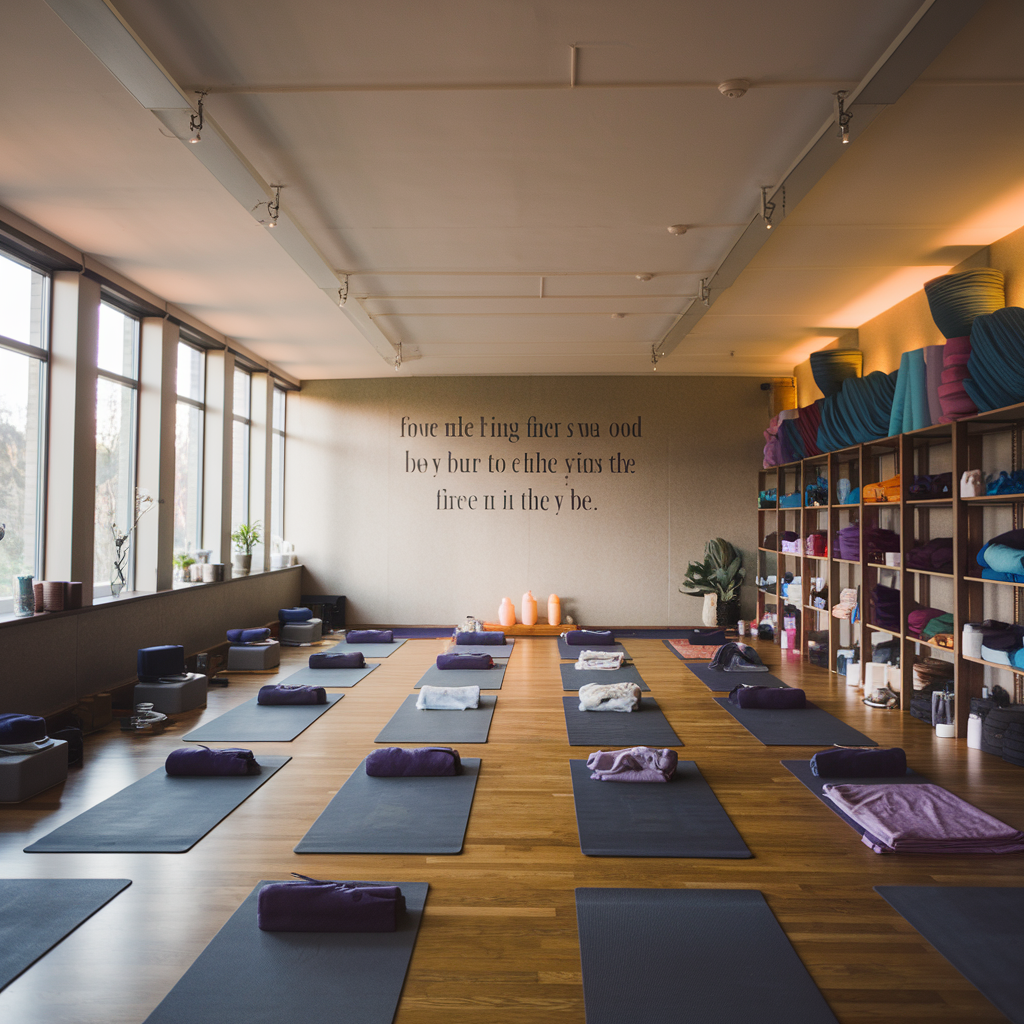Starting a yoga journey is more than just learning poses. The setting for your practice is crucial. It helps you focus, find peace, and enjoy your practice more. We’ll look at what makes a great yoga background, from its history to practical tips for setting up your space.
Key Takeaways
- Understand the historical roots and evolution of yoga practice to better appreciate its holistic nature.
- Discover the key elements that make up a perfect yoga background, including lighting, ambiance, and essential props.
- Explore the role of sound, music, and natural elements in enhancing your yoga experience.
- Learn how to create your own dedicated yoga space at home, tailored to your specific needs and preferences.
- Gain insights on choosing the right yoga background for beginners and advanced practitioners alike.

Understanding the Ancient Origins of Yoga Practice
Yoga has been a beloved practice for centuries. It has roots deep in ancient history. From the yoga sutras of Patanjali to the Vedic traditions, yoga’s story shows our ancestors’ wisdom.
Early Vedic Influences on Modern Yoga
The Vedas, ancient scriptures, are the foundation of Hindu philosophy. They date back thousands of years. These texts laid the groundwork for yoga’s history and practices.
The Upanishads, part of the Vedas, explored yoga’s spiritual and philosophical sides. They helped shape yoga’s holistic approach to well-being.
The Evolution Through Different Historical Periods
Yoga evolved over time, adapting to society’s needs. In the classical period, Patanjali’s yoga sutras brought together yoga’s various strands. This created a comprehensive system.
In the medieval period, hatha yoga emerged. It focused on yoga’s physical aspects. This made yoga more appealing and accessible.
Key Historical Figures in Yoga Development
- Patanjali, the author of the Yoga Sutras, is revered as the father of modern yoga.
- Swami Vivekananda, a 19th-century philosopher, played a pivotal role in introducing yoga to the West and popularizing its holistic approach.
- B.K.S. Iyengar, a renowned yoga teacher, developed the Iyengar method, which emphasizes precise alignment and the use of props.
The journey of yoga is a mix of tradition, innovation, and the quest for well-being. Knowing its ancient yoga practices and key figures helps us appreciate this timeless practice.
Essential Elements of a Perfect Yoga Background
Creating the perfect yoga background is key for a great practice. Whether you’re working on yoga asanas, yoga meditation, or yoga pranayama, the right setting makes a big difference. Let’s look at what makes a perfect yoga space.
A clean and clutter-free space is essential. A calm, open area helps your mind focus and body move freely. Make sure your yoga spot is free from distractions and clutter, creating a peaceful atmosphere.
Good lighting is also important. Soft, natural light or well-placed lamps create a relaxing mood. Avoid bright, harsh lights that can disturb your practice.
Keeping the temperature right is crucial too. A comfortable, steady temperature lets you move easily without getting too hot or cold. This keeps you focused and present during your yoga.
| Essential Yoga Props | Purpose |
|---|---|
| Yoga mat | Provides a stable, non-slip surface for your practice |
| Yoga blocks | Supports and assists in proper alignment during asanas |
| Yoga strap | Helps with flexibility and mobility in certain poses |
| Yoga bolster | Offers support and comfort during restorative poses |
Having the right props and equipment is also vital. From a good yoga mat to supportive blocks and straps, the right tools help you practice better. They’re useful for all yoga levels and styles.

By focusing on these key elements, you can make a yoga space that supports your practice. This lets you dive deep into yoga’s transformative power.
Creating Your Ideal Yoga Space at Home
Having a dedicated yoga space at home can really boost your yoga background and yoga lifestyle. Think about the lighting, ambiance, space, and props you need. This way, you can make a peaceful spot for your yoga.
Lighting and Ambiance Considerations
Good lighting sets the mood for your yoga. Choose soft, natural light to help you relax. You might use dimmable lamps, candles, or windows for natural light. Try out different lights to find what feels right for you.
Space Requirements and Room Setup
Make sure your yoga space is big enough to move around. Pick a quiet, clean area, like a room or a corner. Measure the space and arrange it so you have room for your mat and props.
Essential Props and Equipment
- Yoga mat: Get a good, non-slip mat for comfort and stability.
- Yoga blocks: They help with pose alignment and support.
- Yoga strap: It helps stretch and improve movement.
- Meditation cushion: A comfy cushion is great for meditation.
- Blanket: Use a soft blanket for warmth or support.
Creating your yoga space thoughtfully makes a special place for your yoga background and yoga lifestyle. Play with different elements to find what works best for you.

The Role of Sound and Music in Yoga Practice
Sound and music play a big role in yoga. They help you relax and focus. Adding calming sounds to your yoga meditation and yoga background can make your practice better. It helps you find peace and focus.
Yoga has always known the power of sound. It uses sounds like mantras and singing bowls to calm the mind. These sounds help quiet your thoughts, reduce stress, and lead you to deep relaxation.
“Music can be a powerful tool for deepening your yoga practice. The right sounds can help you connect with your breath, find your center, and tap into a profound sense of inner peace.” – Yoga Instructor, Sarah Johnson
Choosing the right music for your yoga meditation is key. Look for calming, soothing sounds without distracting lyrics or sudden changes. Nature sounds, like waves or leaves, can also create a peaceful space.
- Try different yoga background music, like:
- Instrumental, soothing melodies
- Binaural beats and isochronic tones
- Gentle, natural soundscapes
- Make sure the audio is at the right volume and doesn’t distract you.
- Use headphones or speakers that make you feel like you’re in the sound.
Using sound and music in your yoga meditation can take your practice to a new level. It can help you relax, focus, and connect with your spirit. Discover how audio can improve your yoga background and enhance your practice.

Incorporating Natural Elements for Enhanced Practice
Improving your yoga experience is more than just the poses and breathing. Adding natural elements to your space can make it more harmonious. This can nourish your body and mind. Indoor plants and natural light are simple ways to enhance your practice and deepen your yoga journey.
Benefits of Indoor Plants in Yoga Spaces
Adding plants to your yoga area can greatly benefit you. They bring natural beauty and can lower stress, improve air, and boost creativity and focus. These are key for a fulfilling yoga background. Choose plants that are easy to care for and fit your space’s lighting.
Natural Light and Its Impact
Natural light is crucial for a yoga lifestyle. It can lift your mood, help your body clock, and improve your well-being. Place your mat where you can get sunlight, whether from windows, skylights, or doors. Light and shadow can also make your practice more meditative.
Using Natural Materials
- Use eco-friendly materials like bamboo, cork, or organic cotton for a sustainable feel.
- Natural fibers and materials can make your practice more soothing and tactile.
- Think about natural fiber mats, wood or stone accessories, and organic textiles for props and furnishings.
By adding these natural elements, you can create a yoga space that’s both beautiful and nourishing. Let nature help you elevate your practice and find more mindfulness and well-being.

Different Styles of Yoga and Their Ideal Backgrounds
Yoga isn’t a one-size-fits-all practice. Each style of yoga asanas, yoga meditation, and yoga pranayama needs its own setting to work best. Let’s look at how different yoga styles do well in certain environments.
Hatha yoga focuses on poses and breathing. It does best in a calm, simple space. Natural light, soft fabrics, and a calm color scheme help create a peaceful vibe for the slow, focused movements and deep breathing.
Vinyasa yoga is all about flowing poses. It needs a lively setting. A big, airy room with high ceilings and natural touches like wood or stone fits the fast-paced, rhythmic flow.
- Yin yoga is all about slow, passive poses. It does well in a cozy, dim room. This helps with deep relaxation and thinking.
- Restorative yoga is for total rest and healing. It needs a comfy, caring space with lots of props and cushions.
| Yoga Style | Ideal Background |
|---|---|
| Hatha Yoga | Serene, minimalist, with natural light and neutral colors |
| Vinyasa Yoga | Open, airy space with natural elements like wood or stone |
| Yin Yoga | Cozy, dimly lit environment to foster deep relaxation |
| Restorative Yoga | Comfortable, nurturing space with ample props and cushions |
Knowing what each yoga style needs helps you set up the perfect space. This way, you can fully enjoy your yoga asanas, yoga meditation, and yoga pranayama practice.

How to Choose the Right Yoga Background for Beginners
Starting your yoga journey is exciting and can change your life. But, picking the right yoga background is key, especially for newbies. Your space should meet your needs and inspire you. Let’s look at what makes a great yoga background for beginners.
Starting Your Journey
Beginners need a strong start. First, check your space and what you have. Think about the room’s size, light, and feel. A calm place helps you focus and enjoy your practice.
Basic Setup Requirements
- A comfortable and non-slip yoga mat
- Adequate space to move freely, with minimal clutter and obstacles
- Proper lighting, either natural or artificial, to create a calming atmosphere
- Optional props like blocks, straps, or blankets to support your practice
Common Beginner Mistakes to Avoid
Setting up your yoga space right is key. Avoid these common mistakes:
- Choosing a small or cluttered space that limits your movement and focus
- Ignoring the importance of good lighting and a soothing atmosphere
- Not getting a comfy, non-slip yoga mat
- Not using essential props that can improve your practice
By avoiding these mistakes and setting up the right space, you’ll enjoy a rewarding yoga journey.

Advanced Considerations for Yoga Background Setup
As you get deeper into yoga, setting up a good background becomes key. Yoga experts share tips on making your practice space better. This can make your yoga journey more spiritual and physical.
Adding yoga philosophy to your practice can take it up a notch. Use symbols like the Om or Mandala to add meaning to your space. Also, Ayurveda can help balance the energy in your yoga area.
The materials and textures in your space matter a lot. Choose natural, quality fabrics and add wood, stone, or crystals. These elements create a peaceful and grounding place. Paying attention to details, like choosing the right props, makes your space look and feel better.

Hello, I’m Jane, founder of Home Vibe Ideas. I’m here to inspire stylish Home Design, modern Smart Living, beautiful Outdoor Spaces, and creative DIY Projects to help you create a home that’s uniquely yours.
Disclosure: This post contains affiliate links. If you click on a link and make a purchase, we may earn a small commission at no additional cost to you. The content on this site was created with the help of AI technology.


